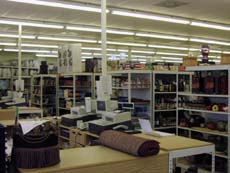index
Physical discontinuous places
click on images for full-size:



The flow of goods: the Tuesday Morning chain of discount stores

The flow of goods: visible linkage
For discontinuous places we don't need to go all the way to virtual reality. There are everyday examples. And there are more networks than the Internet and television. Our spaces are increasingly linked together by huge infrastructures sustained by the cooperation of widely separated groups and individuals. We live in spaces penetrated by networks that deliver flows and goods of all sorts, and our communities are filled with "configurations of foreign elements serving all manner of commercial and institutional purposes. . . . Vast contemporary supply forms, webs and networks, and widely dispersed institutional and commercial configurations are increasingly apparent" (Habraken 1998, 204; see also 259). Our commercial and cultural lives are maintained by networks of "foreign" organizations, and by their "subsidiary manufacturing facilities, dealerships, retail outlets, chain franchises, representatives of religious and political networks, and military bases" (203). Ordinary places are no longer so local. Could such transport and delivery connections allow the creation of discontinuous places? Could a network or a combination of networks become a discontinuous place?